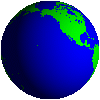"Confronting the Coral Reef Crisis: Indicators of vulnerability"
Beltwood, Hughes,Folke, & Nystrom
Nature, June 24, 2004, [429:6994], pp. 827-833.
![]()
"The worldwide decline of coral reefs call for an urgent reassessment of current management practices."
Confronting large-scale crises requires a major scaling-up of management efforts based on an improved understanding of the ecological processes that underlie reef resilience. Managing for improved resilience, incorporating the role of human activity in shaping ecosystems, provides a basis for coping with uncertainty, future changes and ecological surprises. Here we review the ecological roles of critical functional groups (both for corals and reef fishes) that are fundamental to understanding resilience and avoiding phase shifts {major changes in conditions from one state to another} from coral dominance to less desirable degraded ecosystems. We identify striking biogeographic distances in the species have profound implications for restoration of degraded reefs, management of fisheries, and the focus on marine protected areas and biodiversity hotspots as priorities for conservation."
The overall goal of coral reef management is to sustain the ability of tropical reefs to provide the ecosystem goods and services (for example, fisheries, tourism, aesthetic and cultural values), upon which human welfare depends. ...Instead, coral reefs worldwide are in serious decline, owing primarily to over-harvesting, pollution, disease, and climate change."
p. 827.
Coral reefs, by definition, are three dimensional shallow water structures dominated by scleractinian (hard) corals. In the absence of severe human impacts, reefs readily reassemble after routine disturbances such as tropical hurricanes."
IBID.
"Until now there has been little success in predicting such regime or phase shifts, because the increased instability of coral reef ecosystems before they collapse."
"The most familiar of these transitions [ referred to in the article as --regime or phase shifts-- because the dominant coral forms in one state are replaced by something else in a subsequent state.] is from dominance by corals to dominance by fleshy seaweed, although several other transitions have been documented."
Phases or transition states are:
| phase | ambient or resultant conditions |
|
healthy
state
|
low
turbidity, temperature 70-94º F, sun
|
|
macro-algae
state
|
over-fishing
of herbivores, excess nutrients
|
|
sea
urchin state
|
over-fishing
of echinoid predators, more nutrients
|
|
rock
|
barren
|
p. 828.
"This cryptic loss of coral reef resilience can be manifested in numerous ways. For example, the collapse of many Caribbean coral reefs was long preceded by dwindling stocks of fishes and increased nutrient and runoff from the land."
"In the Caribbean, several critical functional groups are missing or represented by only a handful of species."
| acropora cervicornis | staghorn coral | fore reef zone |
| acropora palmata | elkhorn or tabular coral | reef crest |
"both species were added to in 1999 to the Candidate Species List of the US Endangered Species Act, a sad reflection of our inability to implement regional scale management of Caribbean Reefs."
p. 829.
But does high species richness confer a degree of ecological insurance for ecosystem performance. As suggested by some small-scale experimental studies of biodiversity and ecosystem function? The available evidence for coral reefs is equivocal."
IBID.
"In the United States, in comparison [to Australia], there are more modest plans to increase the NTAs to incorporate 20% of the reefs by 2010, a clear case of too little too late."
p. 831.
"We conclude with four major recommendations for managing human activities in coral reef ecosystems.
1. The size of current "no take areas' or NTAs must be increased"hugely."
2. Focus on NTAs and "hot spots" should not detract from managing heavily fished shoals.
3. users must be educated to become stewards of reef resources in a proactive and involved way.
4. reform of markets through economic incentives to decrease pressure on critical functional species.
p. 832.
El Nino and Southern Ocean Oscillation affects on coral reefs

Like tree rings that reveal the age of centuries-old cedar, growth rings in Indian Ocean coral tell how El Niño, the warm-water phenomenon of the tropical Pacific Ocean, influences marine temperatures a continent away.
"We found a record of climate change that reflected the influence of the tropical Pacific (El Niño) on [the Indian Ocean]. This record tells us a story that has broad climate implications," said Julia Cole of the University of Arizona and co-author of a report on coral growth rings. "ENSO (El Niño/Southern Oscillation) has a very long reach. El Niño brings more rain to East Africa just as it does to Arizona, but it also warms the oceans there."
Reliable records of sea temperatures in the western Indian Ocean date back only a few decades, and scientists have been hard-pressed to decipher the long-term influence of El Niño on these temperatures. Coral rings are filling in the gaps.
"Climate data from this part of the world is limited," said Cole. "But coral can grow for centuries. We know that El Niño affects the inter-annual climate, which is the variability from year to year. El Niño also has a long-term cycle and we found that decadal variations of El Niño drive decadal variability in the Indian Ocean. People have never looked at the decadal variability and attributed it to the Pacific Ocean and El Niño."
 |
|
| Researchers explored the western Indian Ocean, where they found clues from coral reefs to verify temperature fluctuations associated with El Niño. | |
Studying temperature records together with coral growth rings, the researchers discovered a correlation between El Niño in the tropical Pacific and higher surface temperatures in the Indian Ocean. El Niño, they conclude, has a greater effect than Asian and African monsoons on sea-surface temperatures in the Indian Ocean.
"Our study indicates that in addition to being responsible for some of the year-to-year changes in East African climate, ENSO may also set the pace for slower decadal changes," said Cole.
ENSO refers to oceanic and atmospheric fluctuations that originate in the tropical Pacific and affect climate in various areas across the globe.
"Only when we have a long-term perspective can we say anything at all about long-term variability, especially decadal variability," said Cole.
The study provides clues to the role oceans play in the grand global climate scheme. It will also help forecasters better predict the weather.
"One new piece of information the long-term perspective gives us is that the temperature in the region over the last decade was warmer than during the past two centuries," said Cole. "There are not many records of actual ocean temperatures, so adding ocean measurements to the pool, that's one more piece of information that makes a strong case something unusual is going on."
The unusual occurrence is global warming.
"When there's a long record of climate, like the one from the coral, we can ask the question of whether recent warm conditions are unusual or part of a natural cycle," said Cole. "What we found is just one of many cycles that show warming is not part of the natural cycle.
The scientists didn't directly study the effects of El Niño's warm water on the coral. But they note that when seawater gets unusually warm, coral suffers.
"Many corals die when sea temperature exceeds 31 degrees centigrade (94 degrees Fahrenheit)," said Tim McClanahan of the Wildlife Conservation Society and a member of the research team. "The effects of El Niño have killed many of the corals in the western Indian Ocean, despite being far from the center of the El Niño phenomenon. Our study shows that we can expect more warming and coral mortality in the future, which is making local and national management of reefs difficult."
The researchers studied a resilient, abundant coral off the coast of Kenya with growth rings dating back to 1801. They found this living thermometer, called Porites lutea, about 20 feet underwater near Malindi Marine Park. They drilled a small core through the 12-foot-tall coral and assessed the colony.
Chemical changes in the rings tell the story of sea temperature. When the water is warm, the coral reveals light oxygen. When the water is cold, the coral is saturated with heavy oxygen.
"We cored up and down the Kenya coast, from the Tanzanian border to Malindi," said Cole. "We had the advantage of local ecologists on the project with us, and they helped us find the best sites."
Cole, McClanahan, Robert Dunbar of Stanford University and Nyawira Muthiga of the Kenya Wildlife Service collaborated on the report, which was published in the Jan. 28 issue of Science.
Copyright 2000, Environmental News Network, All Rights Reserved
| More on adaptive management. | The cost of cleanup? | What is an externality? |
Vocabulary
phase, the status or condition characteristic of one set of measurements, such as temperature, turbidity, species composition, plant cover, or structural integrity that is discernibly different from another set of conditions. Measures that describe one state are markedly different from and diverge so far from one condition to another that the transition is either abrupt or sharply visible.
cryptic, the signs, signals, indicators or warnings are not obvious; they are hidden or suppressed.
indicator species, the species of plant, animal, or protist is functionally so important that it either reveals the range of conditions for many other creatures, or it forms a node --a nexus if you will-- in the food chain such that if it is removed or its conditions are deteriorating, those creatures that feed on the key or nodal species will also disappear.
Keystone species, the Sea Otter (Enhydra lutris lutris) plays this role in Monterey Bay and central California near shore waters where kelp beds provide the nourishment for the otters favorite snails and echinoderms. The sea otter is a predator on echinoderms, or sea urchins and thus they "crop" or control the number of urchins. Since urchins feed at the base, or hold fast of the kelp (large brown algae [Macrocystis, sp.]), too many urchins can denude shorelines of these extensive "kelp forests." Because of the role , function, or feeding behavior of the sea otter, the (critter) creature is recognized in the scientific literature as a "keystone species."
Florida Keys as coral islands.
Last Updated on February 17, 2008 .
schedule | Research home | Atlas | site-map | Ecology | laws | reliable web sites | quick look
Science Index | Site Analysis | Population Index | Global Warming Index | Nature Index | Research sites | Genes